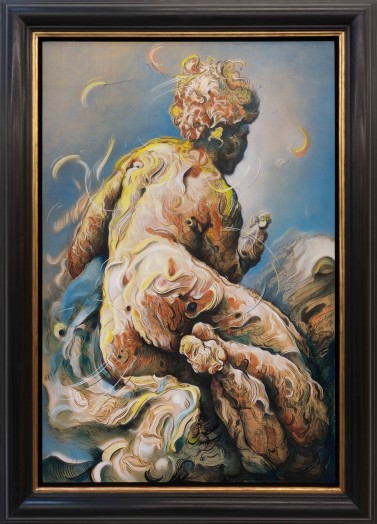In the Altogether: Galerie Max Hetzler, Paris
Over a career spanning more than three decades of painting, drawing and sculpture, Brown has explored concerns of a technical, aesthetic and spiritual nature. Drawing on art history as much as popular culture, his practice engages with an array of genres, movements and styles. Refusing to be confined to a specific medium or temporality, Brown’s work incorporates references to ‘high’ and ‘low’ art forms, from Old Master paintings and religious iconography to science-fiction and contemporary music, with the latter often alluded to through his titles. His sources include published or downloaded versions of still-lifes, landscapes, portraits, nudes and celestial imagery, from periods including the Renaissance, Mannerism, Baroque, Rococo, Neoclassicism and French Romanticism. Teetering between academic and iconoclastic, the sources undergo a process of digital manipulation, after which Brown begins to paint, transposing both colour and form into compositions of unparalleled uncanniness.
Positioning the human figure and colour as its central tenets, Brown’s new body of work appears to vibrate under the viewers’ gaze. The bold and often unnatural hues are ‘very kitsch,’ states the artist, ‘and refer to Vladimir Tretchikoff’, the twentieth-century Russian artist known for his intrepid use of colour. Sinuous, curling and twisting, his signature brushstrokes produce subtle lighting effects. Brown’s paintings are frequently self-referential, drawing from and alluding to his own previous compositions and colour palettes. Set against a saturated sky of moody, drifting clouds, the floating head in Up Life Gone Star, 2024, recalls Brown’s earlier works Fat Boy (1945), 2018, and Black Ships Ate the Sky, 2020. Seemingly hurtling towards earth, the cherub-like head with its wispy curls of yellow, pink and blue streaked hair, is once alluring and unsettling, endearing and tragic..
In the painting In the Arms of the Milky Way, 2024, two children are portrayed in striking hues of cobalt blue and kryptonite green, with flaming yellow and red hair respectively. The disparate colours seem to isolate them, even if they are physically close. Highlighting the influence of Sci-Fi on the artist’s practice, the title plays on the notion that our solar system sits quite literally in an outer arm of the Milky Way galaxy, while simultaneously alluding to the sacred and universal comfort of mothers’ milk. The sulphur yellow figures in Dirty Little Seahorses and When the Satellite Sings, both 2024, further emphasise Brown’s engagement with science-fiction. In each work, the bodies are rendered with coalescing swirls of paint: they appear distorted, the heads condensed, the legs enlarged, signifying the dominance of the body over the mind.
Replete with lithe forms, curved lines and lyrical gestures, Brown’s paintings pulsate with perceived energy. ‘I am trying to keep the viewer’s eye moving, sliding and dancing across the surface of the work like a piece of music by George Frideric Handel’, he explains. A number of works, including Plastic Soul, 2024, and The Hoi Polloi, 2024, present rounded corners, a recurring feature in the artist’s practice, first introduced in his 2004 painting International Velvet. In both works, snaking tendrils of paint swill between foreground and background, whilst in Plastic Soul, delicate strokes in a light chestnut hue create a wood graining effect. Brown’s paintings demonstrate a fascination with the impasto techniques of painters such as Frank Auerbach (b. 1931), as much as with the plumy lines at play in the drawings and studies of Old Masters including Albrecht Dürer (1471–1528) and Abraham Bloemaert (1564–1651). Ostensibly impasto, the surfaces of his works are in fact seductively, almost photographically smooth, while the sketch-like lines of the artist’s source images have been meticulously translated into seamless brushstrokes in oil and acrylic paint. As if belying the pull of gravity itself, Brown’s painted figures and forms appear to float in time and space on undefined ground.
Glenn Brown (b. 1966, Hexham), lives and works in London. In 2000, he was nominated for the Turner Prize. Brown had solo exhibitions in renowned institutions including The Brown Collection, London (2023–2024); Sprengel Museum, Hannover; Landesmuseum Hannover (both 2023); Musée National Eugène Delacroix, Paris (2019); Laing Art Gallery, Newcastle; Jordan Schnitzer Museum of Art, Eugene, Oregon; British Museum, London (all 2018); Museo Stefano Bardini, Florence; Rembrandt House Museum, Amsterdam (both 2017); Contemporary Art Center, Cincinnati, Ohio (2016–2017); Des Moines Art Center, Iowa; Fondation Vincent Van Gogh, Arles (both 2016); Frans Hals Museum, Haarlem (2013 2014); Upton House, Oxfordshire (2012–2013); Ludwig Museum, Budapest (2010); Fondazione Sandretto Re Rebaudengo, Turin; Tate Liverpool (both 2009); Kunsthistorisches Museum, Vienna (2008); Serpentine Gallery, London (2004); and Domaine de Kerguéhennec, France (2000), among others.
Brown's work is part of the collections of the Art Institute of Chicago; British Museum, London; Centre Pompidou, Paris; Fondazione Sandretto Re Rebaudengo, Turin; FRAC – Limousin, Limoges; The Laing Art Gallery, Newcastle; The Museum of Modern Art, New York; Tate, London; and Walker Art Center, Minneapolis.
Artworks
-
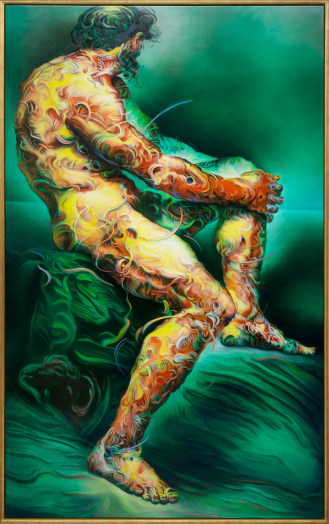 Glenn BrownWhen the Satellite Sings, 2024Oil and acrylic on panel, in artist's frame197.6 x 122 cm (77 3/4 x 48 in)
Glenn BrownWhen the Satellite Sings, 2024Oil and acrylic on panel, in artist's frame197.6 x 122 cm (77 3/4 x 48 in) -
 Glenn BrownDirty Little Seahorses, 2024Oil and acrylic on panel, in artist's frame197.4 x 122 cm (77 3/4 x 48 in)
Glenn BrownDirty Little Seahorses, 2024Oil and acrylic on panel, in artist's frame197.4 x 122 cm (77 3/4 x 48 in) -
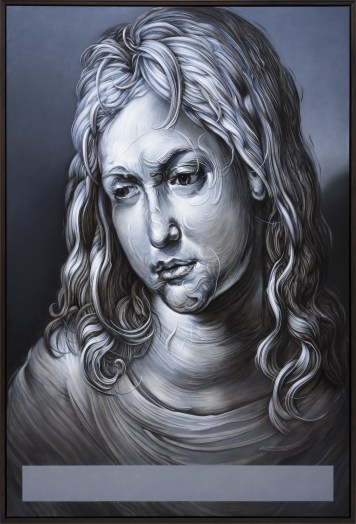 Glenn BrownThe Untitled, 2024Oil on panel, in artist's frame181.5 x 121 cm (71 1/2 x 47 5/8 in) panel
Glenn BrownThe Untitled, 2024Oil on panel, in artist's frame181.5 x 121 cm (71 1/2 x 47 5/8 in) panel -
Glenn BrownThe Hoi Polloi, 2024Oil, acrylic and Indian ink on cherry wood panel, in artist's frame170 x 121 cm (66 7/8 x 47 5/8 in) panel
-
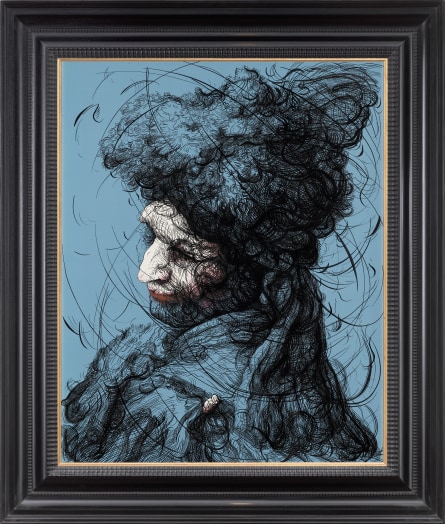 Glenn BrownSonnet Lover, 2024Acrylic and Indian ink on panel, in frame92 x 75.2 cm (36 1/4 x 29 5/8 in) panel
Glenn BrownSonnet Lover, 2024Acrylic and Indian ink on panel, in frame92 x 75.2 cm (36 1/4 x 29 5/8 in) panel
113 x 97 x 8 cm (44 1/2 x 38 1/4 x 3 1/8 in) frame -
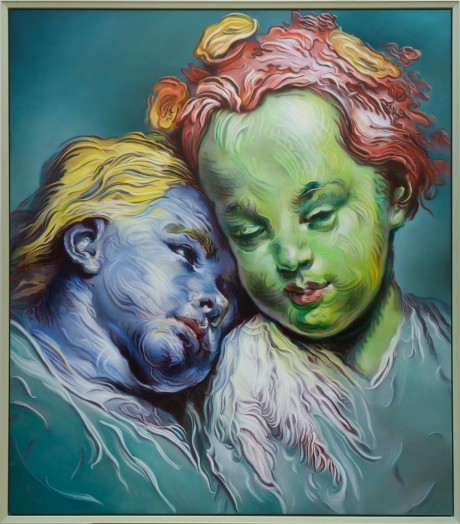 Glenn BrownIn the Arms of the Milky Way, 2024Oil and acrylic on panel, in artist's frame156.4 x 136.3 cm (61 5/8 x 53 5/8 in)
Glenn BrownIn the Arms of the Milky Way, 2024Oil and acrylic on panel, in artist's frame156.4 x 136.3 cm (61 5/8 x 53 5/8 in) -
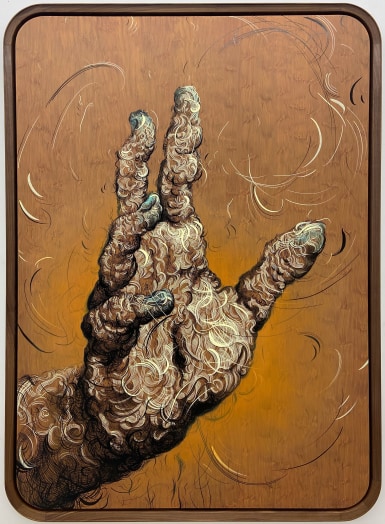 Glenn BrownPlastic Soul, 2024Oil, acrylic and Indian ink on panel, in artist's frame126 x 90 cm (49 5/8 x 35 3/8 in)
Glenn BrownPlastic Soul, 2024Oil, acrylic and Indian ink on panel, in artist's frame126 x 90 cm (49 5/8 x 35 3/8 in) -
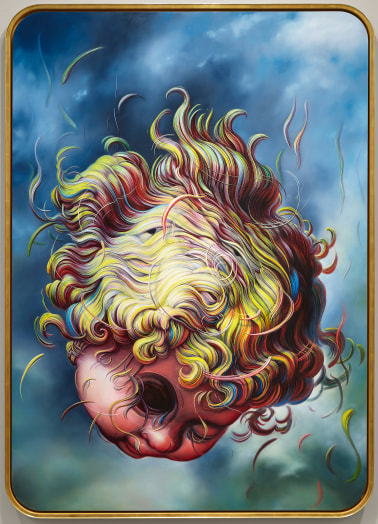 Glenn BrownUp Life Gone Star, 2024Oil, acrylic and Indian ink on panel, in artist's frame170 x 121 cm (66 7/8 x 47 5/8 in)
Glenn BrownUp Life Gone Star, 2024Oil, acrylic and Indian ink on panel, in artist's frame170 x 121 cm (66 7/8 x 47 5/8 in)

